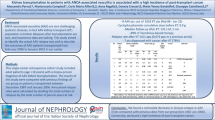Abstract
We report a 62-year-old man who developed biopsy-proven post-transplantation lymphoproliferative disorder (PTLD) 20 years after receiving a heart transplant while being treated with immunosuppressive agents. The patient presented with large retroperitoneal and intestinal wall masses that caused partial gastrointestinal stenosis. Monoclonal antibody against CD20 in conjunction with chemotherapy and tapering of the immunosuppressive regimen was instituted, resulting in objective response of the disease bulk. To the best of our knowledge, this is the second reported case of PTLD 20 years after heart transplantation.



Similar content being viewed by others
References
Yamani MH, Taylor DO, Haire C, Smedira N, Starling RC. Post-transplant ischemic injury is associated with up-regulated AlloMap gene expression. Clin Transplant. 2007;21:523–5.
Roithmaier S, et al. Incidence of malignancies in heart and/or lung transplant recipients: a single-institution experience. J Heart Lung Transplant. 2007;26:845–9.
Leblond V, et al. Identification of prognostic factors in 61 patients with posttransplantation lymphoproliferative disorders. J Clin Oncol. 2001;19:772–8.
Ghobrial IM, et al. Prognostic analysis for survival in adult solid organ transplant recipients with post-transplantation lymphoproliferative disorders. J Clin Oncol. 2005;23:7574–82.
Choquet S, Levy V, Leblond V. Identification of prognostic factors in post-transplantation lymphoproliferative disorders. Bull Cancer. 2004;91:373–8.
Tsai DE, et al. Reduction in immunosuppression as initial therapy for posttransplant lymphoproliferative disorder: analysis of prognostic variables and long-term follow-up of 42 adult patients. Transplantation. 2001;71:1076–88.
LaCasce AS. Post-transplant lymphoproliferative disorders. Oncologist. 2006;11(6):674–80.
Schubert S, et al. Relationship of immunosuppression to Epstein-Barr viral load and lymphoproliferative disease in pediatric heart transplant patients. J Heart Lung Transplant. 2008;27(1):100–5.
Preiksaitis JK, Keay S. Diagnosis and management of posttransplant lymphoproliferative disorder in solid-organ transplant recipients. Clin Infect Dis. 2001;33(Suppl 1):S38–46.
Wasson S, Zafar MN, Best J, Reddy HK. Post-transplantation lymphoproliferative disorder in heart and kidney transplant patients: a single-center experience. J Cardiovasc Pharmacol Ther. 2006;11(1):77–83.
Swinnen LJ, Fischer RI. OKT3 monoclonal antibodies induce interleukin-6 and interleukin-10: a possible cause of lymphoproliferative disorders associated with transplantation. Curr Opin Nephrol Hypertens. 1993;2:670–8.
Opel ZG, Dohler G. Lymphomas after solid organ transplantation: a collaborative transplant study report. Am J Transplant. 2004;4:222–30.
Keever-Taylor CA, et al. Complement-mediated T-cell depletion of bone marrow: comparison of T10B9. 1A–31 and Muromonab-Orthoclone OKT3. Cytotherapy. 2001;3(6):467–81.
Ciancio G, et al. Post-transplant lymphoproliferative disease in kidney transplant patients in the new immunosuppressive era. Clin Transplant. 1997;11(3):243–9.
Cohen JI. Epstein-Barr virus infection. N Engl J Med. 2000;343(7):481–92.
Schulz TF. Cancer and viral infections in immunocompromised individuals. Int J Cancer. 2009;125(8):1755–63.
Yates J, Warren N, Reisman D, Sugden B. A cis-acting element from the Epstein-Barr viral genome that permits stable replication of recombinant plasmids in latently infected cells. Proc Natl Acad Sci U S A. 1984;81:3806–10.
Johannsen E, et al. Epstein-Barr virus nuclear protein 2 transactivation of the latent membrane protein 1 promoter is mediated by J kappa and PU. 1. J Virol. 1995;69:253–62.
Wang F, et al. Epstein-Barr virus latent membrane protein (LMP1) and nuclear proteins 2 and 3C are effectors of phenotypic changes in B lymphocytes: EBNA-2 and LMP1 cooperatively induce CD23. J Virol. 1990;64:2309–18.
Capello D, Rossi D, Gaidano G. Post-transplant lymphoproliferative disorders: molecular basis of disease histogenesis and pathogenesis. Hematol Oncol. 2005;23:61–7.
Bräuninger A, et al. Epstein-Barr virus (EBV)-positive lymphoproliferations in post-transplant patients show immunoglobulin V gene mutation patterns suggesting interference of EBV with normal B cell differentiation processes. Eur J Immunol. 2003;33:1593–602.
Mosialos G, et al. The Epstein-Barr virus transforming protein LMP1 engages signaling proteins for the tumor necrosis factor receptor family. Cell. 1995;80:389–99.
Capello D, Berra E, Cerri M, Gaidano G. Post-transplant lymphoproliferative disorders. Molecular analysis of histogenesis and pathogenesis. Minerva Med. 2004;95:53–64.
Novoa-Takara L, et al. Histogenetic phenotypes of B cells in posttransplant lymphoproliferative disorders by immunohistochemical analysis correlate with transplant type: solid organ vs hematopoietic stem cell transplantation. Am J Clin Pathol. 2005;123:104–12.
Paya CV, et al. Epstein-Barr virus-induced posttransplant lymphoproliferative disorders. ASTS/ASTP EBV-PTLD task force and the mayo clinic organized international consensus development meeting. Transplantation. 1999;68:1517–25.
Green M, Reyes J, Webber S, Rowe D. The role of antiviral and immunoglobulin therapy in the prevention of Epstein-Barr virus infection and post-transplant lymphoproliferative disease following solid organ transplantation. Transpl Infect Dis. 2001;3:97–103.
Middeldorp JM, Brink AA, van den Brule AJ, Meijer CJ. Pathogenic roles for Epstein-Barr virus (EBV) gene products in EBV-associated proliferative disorders. Crit Rev Oncol Hematol. 2003;45(1):1–36.
Davis CL, et al. Interferon-alpha treatment in post-transplant lymphoproliferative disorder in recipients of solid organ transplants. Transplantation. 1998;66:1770–9.
Choquel S, et al. Efficacy and safety of rituximab in B-cell post-transplantation lymphoproliferative disorders: results of a prospective multicenter phase 2 study. Blood. 2006;107:3053–7.
Choquet S, et al. Rituximab in the management of post-transplantation lymphoproliferative disorder after solid organ transplantation: proceed with caution. Ann Hematol. 2007;86:599–607.
Hande KR, Garrow GC. Acute tumor lysis syndrome in patients with high-grade non-Hodgkin’s lymphoma. Am J Med. 1993;94(2):133–9.
Montesinos P, et al. Tumor lysis syndrome in patients with acute myeloid leukemia: identification of risk factors and development of a predictive model. Haematologica. 2008;93(1):67–74.
Alavi S, Arzanian MT, Abbasian MR, Ashena Z. Tumor lysis syndrome in children with non-Hodgkin lymphoma. Pediatr Hematol Oncol. 2006;23(1):65–70.
Kaleem Z, Hassan A, Pathan MH, White G. Flow cytometric evaluation of posttransplant B-cell lymphoproliferative disorders. Arch Pathol Lab Med. 2004;128:181–6.
Buadi FK, et al. Treatment and outcomes of post-transplant lymphoproliferative disease: a single institution study. Am J Hematol. 2007;82(3):208–14.
Acknowledgments
We acknowledge Dr Steve Hou and Dr Jabed Iqbal from the Department of Pathology for their significant contributions in the interpretation of the pathology report.
Conflict of interest statement
None declared.
Author information
Authors and Affiliations
Corresponding author
Rights and permissions
About this article
Cite this article
Grivas, P.D. Post-transplantation lymphoproliferative disorder (PTLD) twenty years after heart transplantation: a case report and review of the literature. Med Oncol 28, 829–834 (2011). https://doi.org/10.1007/s12032-010-9523-2
Received:
Accepted:
Published:
Issue Date:
DOI: https://doi.org/10.1007/s12032-010-9523-2




